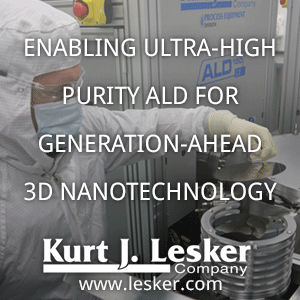The escalating
struggle with further scaling of integrated circuit chips, on account of
certain feature sizes in advanced chips gradually hitting atomic dimensions,
has compelled the semiconductor industry to become more welcoming to new
materials as a possible solution to continued PPAC
(Power-Performance-Area-Cost) improvement. Traditionally not so popular in the
semiconductor industry, Magnesium (Mg) is being explored for use in various
related applications due to the fact that it forms semiconductor compounds with
oxygen, sulfur, selenium, and tellurium.
For example, Magnesium
Oxide (MgO) is a semiconductor with a wide band-gap and semi-insulating
properties. A very thin semi-insulating MgO layer between two metallic
ferromagnetic layers is used as a “magnetic tunnel junction”. Magnetic
tunneling junctions (MTJs) based on the CoFeB/MgO/CoFeB layer have received
great attention as a promising candidate for future spin logic devices. Among
various applications of MTJs, spin-transfer-torque magnetic random access
memory (STT-MRAM) is emerging as a strong candidate as a next-generation
nonvolatile memory due to its simple integration scheme, low voltage operation,
and high speed. To fulfill certain critical requirements of 3D MTJ based sub-20
nm, high-density STT-MRAM, Samsung Advanced Institute of Technology (SAIT),
Korea, has recently investigated both thermal and plasma-enhanced ALD for
depositing a MgO tunnel barrier using bis(cyclopentadienyl)magnesium precursor
under the scope of the Industrial Strategic Technology Development Program
(10041926, Development of high-density plasma technologies for the thin-film
deposition of nanoscale semiconductors and flexible-display processing) funded
by the Ministry of Knowledge Economy (MKE, Korea). (Link)
Figure
1. TEM images of (a) Thermal ALD MgO, (b) PE-ALD
MgO grown at 300 °C on a CoFeB layer
Recently,
Panasonic Corporation, Japan, together with the National Institute of Material
Science, Japan, reported ALD based Magnesium Phosphate (MgPO) thin-films as magnesium-ion
conducting solid-state electrolytes that are considered to be promising candidates
for future energy storage and conversion devices. The deposition was carried
out at lower deposition temperatures, ranging from 125 to 300 °C, using
bis(ethylcyclopentadienyl)magnesium. (Link)
Apart from
semiconductor and energy storage applications, Mg is also an interesting
candidate for astronomical and optical applications. For example, recent NASA
missions that make observations in the ultraviolet, such as the Hubble Space
Telescope and the Galaxy Evolution Explorer, employed primary mirrors coated
with aluminum and further protected by thin films of Magnesium Fluoride (MgF2).
Therefore, the Jet Propulsion Laboratory, California Institute of Technology,
under a contract with NASA, reported ALD of MgF2 using bis(ethylcyclopentadienyl)magnesium supplied by Strem Chemicals, Inc. (Link)
Figure
2. Photograph of a concave mirror and convex
diffraction grating for a next-generation UV instrument prototype coated with
electron beam evaporated aluminum and a protective coating of 10 nm ALD MgF2
deposited at 150 °C.
Strem Chemicals, Inc., a leading fine
chemicals supplier, headquartered in Newburyport, Massachusetts, USA, offers the
most preferred precursors worldwide for ALD of Mg-based compounds, i.e, bis(ethylcyclopentadienyl)magnesium [Mg(CpEt)2] (catalog
number 12-0510). The colorless to pale
yellow liquid phase precursor with a density of 0.95 g/cm3 at 20 °C
and vapor pressure of 0.0315 Torr is also sold by Strem Chemicals as pre-packed
in cylinders:
§ 98-4006: Bis(ethylcyclopentadienyl)magnesium,
min. 98%, 12-0510, contained in 50 ml Swagelok® cylinder (96-1070) for CVD/ALD
§ 98-4010: Bis(ethylcyclopentadienyl)magnesium, min.
98%, 12-0510, contained in high-temp 50 ml Swagelok® cylinder (96-1071) for
CVD/ALD
About Strem
Chemicals: Strem is an
employee-owned fine chemicals supplier, manufacturing and marketing
high-quality specialty chemicals for more than half-a-century. They provide
custom synthesis and FDA inspected current good manufacturing practice (cGMP)
services to its clients from academia as well as industry and also to
government R&D labs. What distinguishes Strem from the other chemical
suppliers are its ISO 9001 Quality Management System (QMS) standard and
documenting procedures including for example “Color and Form” for every product
as listed in the product details as a quality indicator for researchers. This
helps Strem deliver precursors with a minimum metals purity of 99%, with some some metal precursors attaining as high as
99.9999% metal’s purity. Strem offers over 5,000 specialty products in the area
of metals, inorganics, organometallics, and nanomaterials. Strem’s product
range includes:
Products Mentioned in this Blog:
98-4006: Bis(ethylcyclopentadienyl)magnesium,
min. 98%, 12-0510, contained in 50 ml Swagelok® cylinder (96-1070) for CVD/ALD
98-4010:
Bis(ethylcyclopentadienyl)magnesium, min. 98%, 12-0510, contained in high-temp
50 ml Swagelok® cylinder (96-1071) for CVD/ALD
Related Product Lines & Resources:
----------
Promotional blog written and researched by Abhishekkumar Thakur and Jonas Sundqvist, BALD Engineering AB



%20(1).png)




